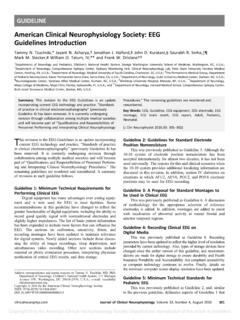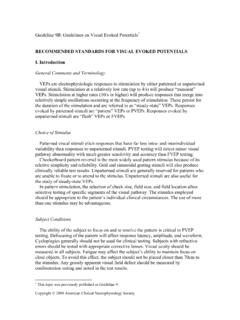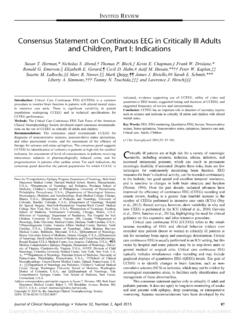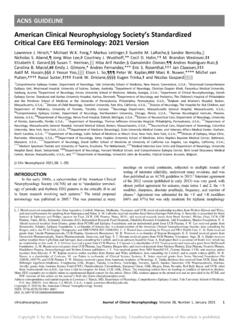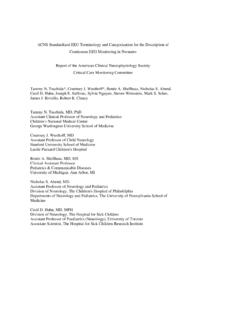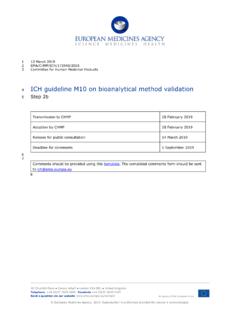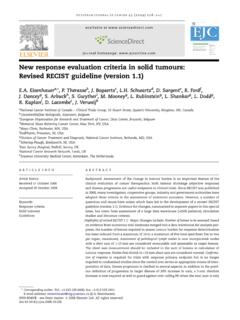Transcription of American Clinical Neurophysiology Society Guideline 3 ...
1 Copyright 2006 American Clinical Neurophysiology 1 American Clinical Neurophysiology Society Guideline 3: minimum Technical Standards for EEG Recording in Suspected Cerebral Death Introduction EEG studies for the determination of cerebral death are no longer confined to major laboratories. Many small hospitals have intensive care units and EEG facilities. The need for minimal standard guidelines has thus increased. The first (1970) edition of minimum Technical Requirements for EEG Recording in Suspected Cerebral Death reflected the state of the art and the technique of the late 1960s.
2 Substantially improved EEG instrumentation is now available, and many laboratories have had years of experience in this area. Equally important, there is now a much larger number of competent EEG technologists. Finally, the EEG results of a collaborative study of cerebral death that was being planned in 1970 have been published (Bennett et al., 1976). The survey in the later 1960s by the American EEG Society s Ad Hoc Committee on EEG Criteria for the Determination of Cerebral Death revealed that, of 2,650 cases of coma with presumably isoelectric EEGs, only three whose records satisfied the committee s criteria showed any recovery of cerebral function.
3 These three had suffered from massive overdoses of nervous system depressants, two from barbiturates, and one from meprobamate. Many of the reported isoelectric records were, on review, either low-voltage records or obtained with tech-niques inadequate to bring out low-voltage activity. That is, inadequate technique alone gave the graphs the appearance of being flat. It should be pointed out, however, that this study did not include children. Hence, the comparable data on which to base recommendations for this young age group do not exist at present.
4 The 1970 committee recommended dropping nonphysiologic terms such as isoelectric or linear (the word flat should likewise not be used) and renaming the state electrocerebral silence. Subsequently, electrocerebral inactivity (ECI) was the term recommended in the Glossary of the International Federation of Clinical Neurophysiology (IFCN; Chatrian et al., 1974). The current Guideline includes an updating of the criteria for electrocerebral inactivity, reflecting what has been learned since the first appearance of these standards (Chatrian et al.)
5 , 1974; Bennett et al., 1976; Chatrian, 1980; NINCDS, 1980; Medical Consultants, 1981; Walker, 1981). Definition Electrocerebral inactivity (ECI) or electrocerebral silence (ECS) is defined as no EEG activity over 2 uV when recording from scalp electrode pairs 10 or more cm apart with interelectrode impedances under 10,000 Ohms (10 KOhms), but over 100 Ohms. Ten guidelines for EEG recordings in cases of suspected cerebral death, with the rationale for each, are set forth with explanatory comments. 1. A Full Set of Scalp Electrodes Should Be Utilized Copyright 2006 American Clinical Neurophysiology 2 The major brain area must be covered to be certain that absence of activity is not a focal phenomenon.
6 The use of a single-channel instrument such as is sometimes used for EEG monitoring of anesthetic levels is therefore unacceptable for the purpose of determining ECI. The frontal, central, occipital, and temporal areas are recommended as the minimal required coverage. A grounding electrode should be added. However, for recordings in intensive care units, a ground electrode should not be used if grounding from other electrical equipment is al-ready attached to the patient. Since, prior to the recording, one does not know whether an ECI record will be obtained, it is desirable to use a full set of scalp electrodes on the initial examination, as defined in Guideline One: minimum Technical Requirements for Performing Clinical Electroencephalography, Section At times, the full set of conventional 10-20 scalp locations may not be accessible because of head trauma or recent surgery.
7 Otherwise, the initial study should not use less than the routine coverage standard for the particular Clinical laboratory. A full set of electrodes includes midline placements (Fz, Cz, Pz); these are useful for the detection of residual low-voltage physiologic activity and are relatively free from artifact. Since the EEGs of patients with suspected ECI actually may have EEG abnormalities other than ECI, the use of more complete, rather than less complete, electrode coverage is often essential. 2. Interelectrode Impedances Should Be Under 10,000 Ohms But Over 100 Ohms Unmatched electrode impedances may distort the EEG.
8 When one electrode has a relatively high impedance compared to the second electrode of the pair, the amplifier becomes unbalanced and is prone to amplify extraneous signals unduly. This may result in the occurrence of 60-Hz interference or other artifacts. Situations characterized by low-voltage electrocerebral activity and high instrument sensitivity demand especially scrupulous electrode application. There is a marked dropoff of potentials with impedances below 100 Ohms and, of course, no potential at 0 Ohms. Such an occurrence could be one possible reason for a false ECI record.
9 A test of inter-electrode impedances to assure that they are of adequate magnitude thus should be performed during the recording. When fixed arrays of electrodes ( electrode cap or similar devices) are utilized, it is essential that excess jelly does not spread from one electrode to another, creating a shunt or short circuit, which would attenuate the signal. Stable, low-impedance electrodes are absolutely essential for all bedside ( , away from the laboratory) studies. Although not recommended for general use, needle electrodes have been used effectively in suspected ECI recordings.
10 The greater impedance they may have is offset by a greater probability of similar values among different electrodes, so that the likelihood that artifact will occur in the record is not increased. (See also Guideline 1: minimum Technical Requirements for Performing Clinical Electroencephalography, Section ) 3. The Integrity of the Entire Recording System Should Be Tested Ordinary instrumental calibration tests the operation of the amplifiers and writer units, but it does not exclude the possibility of shunting or an open circuit at the electrodes, electrode board (jackbox), cable, or input of the machine.
